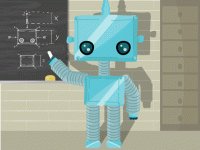The Future of Learning
Edutopia blogger Beth Holland recalls the robot teacher from the Jetsons and updates that 1960s cartoon view of education’s future to include customized learning, embedded technology, ongoing feedback – and human teachers.
Your content has been saved!
Go to My Saved Content.Remember the Jetsons? That iconic family of the future depicted in the 1960s cartoon? They lived in a futuristic society marked by flying cars and advanced technology -- and yet, they learned in a lecture-based system with the teacher (albeit a robot one) directing the process from the front of the room.
We have always struggled to envision the future, often superimposing new technology over our current views. Though the creators of the Jetsons did not have the constraints of standardized tests, limited budgets, or even gravity, their schools closely resembled those of the 1960s -- which, in many ways, still look like those of today. The challenge of imagining the future of learning can seem daunting. However, snapshots already exist. We just need to look beyond our current classrooms to identify some of the key tenets for our learning environments of the future.
Key Tenet #1: Flexible, Customized Learning
The Jetson kids' schools, Orbit High and Little Dipper, mirror many of the teacher-centric learning environments that we see today. However, given the capabilities afforded by new technologies, especially mobile devices, learning no longer needs to be fixed and structured.
The reality of flexible, customized learning environments struck me when I started taking a spin class at the gym. Upon entering the room, I discovered that every bike had been deconstructed -- the handlebars and seats had been removed from the frames. Before beginning, I had an opportunity to set up my learning environment to best fit my physical stature.
Within current classrooms, most of us ask our students to sit in the same types of seats, to use the same texts, notebooks, and technology, and to work within an environment configured primarily by the teacher. Instead of imagining learning environments that look like today's classrooms, we could think about them through the lens of a spinning studio. Students enter the room each day and then configure their space to fit their intellectual stature.
At Eanes ISD in Texas, teachers have begun rearranging their classrooms to become fluid and mobile spaces as a result of their 1:1 iPad initiative. Idea paint covers portions of walls. Chairs and desks easily move for collaborative work, and space has been carved out for quiet, reflective thinkers.
Similarly, at the Hillbrook iLab, students begin their learning with a completely empty space. Tables, desks, chairs, and even walls can be moved to create the ideal environment to support the students' learning. In the future, rather than ask learners to conform to the space, the space could be adapted to the students.
Key Tenet #2: Ubiquitous, Embedded, Invisible Technology
In much the same way that students may configure their physical learning spaces, they could also design their digital ones. Elroy Jetson regularly turned to his "homework helper" to support his learning. However, he had limited access to the machine given its size -- and that it was built into the wall.
It’s hard to believe that the Jetsons were forecasting the year 2030, because in many ways, the real future is already here. Mobile devices could enable Elroy to access his academic support from anywhere at any time. Fifteen years ahead of schedule, technology has truly become ubiquitous. In fact, it is so embedded in our society that all of us carry in our pockets the ability to access information and communicate with others.
In the future, educational technology could also be invisible. As Michael Cohen wrote in The Invisible iPad:
For our students, learning will be completely supported and infused with technology. Seamlessly, tools and apps will buttress the ways in which students consume course content, create artifacts and evidence of their learning, curate objects into an overarching learning experience, and connect with others from around the world. Teachers will no longer focus on how to fit technology into their curriculum. Instead, it will become just another facet of student learning.
Key Tenet #3: Ongoing Diagnostics and Feedback
While the robot teachers from the Jetsons may have effectively managed classroom antics and disseminated content, they did little to differentiate instruction based on personal connections to students.
In 2009, Elizabeth City, Richard Elmore, Sarah Fiarman, and Lee Teitel wrote Instructional Rounds in Education. Applying lessons learned from teaching hospitals, they encouraged school and district leaders to conduct rounds in much the same way as doctors check on their patients. However, in classrooms of the future, not only could administrators complete rounds to provide professional feedback to teachers, but teachers could also conduct daily rounds with their students.
Imagine if teachers ran individualized diagnostics each morning to assess changes in learning, comprehension, and even emotional well-being. Based on that interaction, plans could be adapted to align with the learning status of each student. Rather than developing their curriculum in isolation, teachers could have time during rounds for collaborating with colleagues to create customized, flexible learning plans ensuring that each student received the best possible course of action. While the robot teachers may have been efficient for disseminating content, only a human teacher can nurture essential personal connections with students.
We Can See the Future from Here
In the future, students could learn in flexible, customizable environments designed to best meet their needs and choose from a virtually unlimited quiver of tools and devices. Teachers could continually assess and adapt curriculum to best support their students. And with ubiquitous access to mobile technology, learning is no longer constrained by an arbitrary time period or even the physical dimensions of a school. In the end, we could create resource-rich, student-centric, active learning environments for our students. One thing I wouldn't want to have, though: robot teachers.
